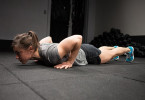[Ed note: you may want to read Fun Times In The Pain Cave before you get into this post. Or, if you’re just here for the rowing tips, you may not. I don’t mind either way.]
In my last post, I talked about the psychological benefits of doing a 7-minute 2k on a rower – a decent standard over the Olympic racing distance – and why you should have a go at one. In this one, I’m going to talk about how to actually get it done. Because there are clever subtleties to yanking on a handle 196 times over the length of Metallica’s One (minus the intro), and you, my dear readers, need to hear them. Let’s do this.
1. Row lots
Oh how glib – and yet, unavoidable. Because apart from strengthening your lungs, heart, and rowing-specific muscles, making the energy pathways involved in a 7-minute power endurance effort more efficient, and improving your confidence in yourself and ability to gauge how much pain you can take, practicing rowing teaches you lots of other things. Like: how the proper technique should feel, and how that varies between the first pulls and the final sprint. How 26 strokes a minute at a 1:40 pace feels, compared to 30. These are things you should know. And anyway, there’s a lesson here: nothing will ever make you as good at the thing as doing the thing. Row every time you hit the gym, even if it’s for a 500m warmup or cool-down. Row for recovery. Row.
2. Attack it from both sides
To do a decent 2k, you need power endurance. You need to be able to sprint, and to maintain a decent pace for a decent length of time. And so what worked for me was following a plan in which I’d do lots of short, hard intervals in a couple of sessions a week, followed by 5-10k recovery-pace rows (so about 2:20 per 500m) to get the blood flowing through my poor, ruined muscles on my ‘recovery’ days. Recovery days are the perfect chance to make every stroke count with proper technique, and also a good chance to experiment with ‘Power 10s’ – 10 hard strokes, in which your pace might get up to 1:38 or something. You will need these for the 2k, where you should sprint the last 250m or so.
I got my training plan from Pieter Vodden and told him I wouldn’t reveal it here: but one bit of advice I can share is that, if you do 10 sets of 500m with a minute of rest in between, your average pace is what you can hold for 2k. You’re going to need average a 1:45 500m for the 7-minute row, obviously. To quote Lena Headey from 300: it won’t be quick, and you will not enjoy it. But you need to get it done.
3. Get the damper setting right
This won’t make it any easier, but it will stop you unnecessarily hamstringing yourself. It really comes down to personal preference – if you’re a lightweight (under 5’10, probably) you might benefit from rowing at a lower damper setting with a higher stroke rate. If you’re a giant powerhouse (in which case you should be aiming for something faster anyway – how does 6:45 sound, big man?), you’ll probably benefit from rowing at a higher setting with a lower stroke rate. I hovered between 6 and 7 for every workout and settled on 7 for the 2k, usually hitting between 26 and 28 strokes a minute, climbing to 30 in the final assault.
When I finally got the 7-minute done (on my fourth attempt), I went with a strategy graciously donated by Sir Matthew Pinsent, four-time Olympic gold medallist, via Twitter. Here’s the man himself:
‘Go off at 1.41 for 30secs, settle to 1.45 flicking 1.46. fight like hell to not see 1.47 in 3rd 500 & sprint if you can.’
This is basically exactly what I did, although I went out a bit too fast and really struggled in the holding on bit. I was ready for the last 250 though, because that’s basically 20 all-out strokes (those Power 10s again) and a final burst of utter savagery. Sir Matt again:
‘It’s the patch from 800-1400m that gets you every time. get your head round that and you’re home.’
Damn straight. In every attempt I made, the 1000m mark was the point where I started playing headgames with myself, internally going ‘You cannot maintain this pace, you’ll die.’ But that’s not true. You won’t die. All you have to do is the same as you’ve already done, a fraction slower, with a burst of effort at the end. You can even fall off the rower afterwards! It’ll be totally fine.
Here’s David Hart again, with a bit more detail: ‘If you’re trying to get the best possible time, when to start the sprint is probably key. Too soon and you’ll blow up and limp home; too late, you’ll have left something in the tank and be left with some what ifs. From a performance point of view, you probably want to be coming off your sprint, so that your times are drifting back to your average pace when you cross the line (e.g. You go from 1:45, sprint to 1:38 and then your times creep back up to 1:45 as you struggle to maintain your sprint for the last few metres). From a performance POV, that’s good. From a “how you feel afterwards”, maybe less so…’





Congratulations, well done!
I went through something similar years ago when I tried to get a sub-8 min 2k. Didn’t manage it, faded at the end. It’s awful when you see your split time going south and you can’t seem to do anything about it. I ended up with 8:05.
Found your stroke rate interesting. Similar to my stroke rate actually, but all the other girls I was rowing against, including the heavyweights, had higher stroke rates than me. They basically all seemed fitter/faster-moving, while I had good leg power.
I didn’t do much aerobic capacity work, like you are suggesting. That might have been the missing link.
Yeah, that’s a comparatively low stroke rate for a guy my size, I think. I put it down to the fact that my lung power isn’t that ferocious but my pulling power is pretty decent – so I was getting a lot of wallop out of every stroke. I never seemed to be able to get a huge amount of leg drive, although my legs were always fried by the end so they must have done something.
The Concept 2 monitor has a nifty “PROJECTED TIME” function on it that calculates at each moment what your finish time will be. If you go for a new PB every 10 or 12 days during your campaign, start at your last PB pace & try NOT to exceed it for the first 1500 metres. It will still be uncomfortable by 1000. But that is halfway – so encourage yourself at that point because anything you can do halfway, you can do all of the way. Start to sprint at 200 to go – 18 to 20 good strokes – and you will likely finish 4 to 6 seconds faster than your PB. I am not a gifted athlete & I eked out a 6:48 over a few months of that peppered in with other forms of training. In my first marathon attempt, I did a 2:47:xx and was slightly disappointed. So 2 weeks later, using the PROJ TIME function again, I came back & hit the 2:45:xx I was looking for. I wish there was a cross-country ski ergometer that fully replicated that function as well as Concept 2 does for rowing.
Good knowledge, thanks. Have you tried the C2’s ski-erg? I haven’t had chance yet, but planning to get round to it.
No. I have seen it, but noted that it looks like an arm action (poling) ergometer only. I yearn for a well-conceived idea of what Nordic Track was shooting for.
Will you share your training plan via email, maybe? … pretty please! 🙂
Sorry guys, it’s not mine to share. You’d need to ask @voddenUNLTD
Only been rowing a few weeks and I’m getting 4.5k in 20 minutes. I can keep constant 200m per minute easily. Getting the extra will take a few more months lol
Keep after it, Mark! Let me know how you get on.